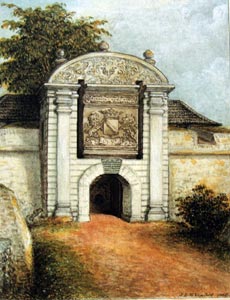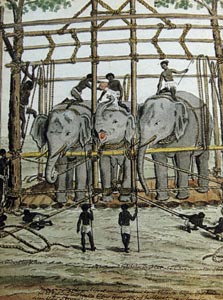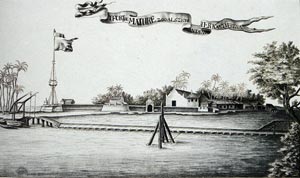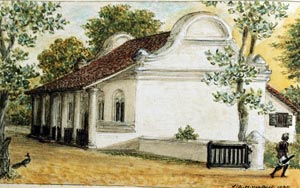“Matara is reportedly the most cultured place in Ceylon, as Kalutara is the healthiest: ‘born in Kalutara, educated in Matara – what better?’ says a proverb,” reports Roland Raven-Hart in Ceylon: History in Stone (1964). As I wrote of Kalutara recently (Colonial Kalutara, the Sunday Times, August 22, 2010), it would now seem appropriate to turn my attention to Matara. This historic and once enormously important seaport was the place where hundreds of captured elephants were quartered until transported to the umbrella of surrounding countries.
“Thirty miles from Point de Galle lies Matura, a captain’s command,” Robert Percival comments in Ceylon (1803). “The fort and village are both small; the country round is exceedingly wild, but well supplied with provisions of all sorts; and game, in particular, is found in great abundance.
“The country around Matara abounds with elephants, and it is here they are principally caught for exportation. Every three or four years the elephant is hunted here, by order of government.” He then mentions a statistic: “In 1797 at one of these hunts, 176 were caught, the greatest number to have been taken at one time.” In 2007, 193 of these animals died in human-elephant conflict.
Willem Schouten, the Dutch explorer, wrote of the embarkation of elephants at Matara: “It is a great deal of trouble to get them on board: the rafts and the boats must be covered with grass and branches of palm-trees, or else the elephants could not be induced to pass along the rafts or bridges. When they have been conducted close to the ship, their eyes are covered, and large bands are passed under the belly embracing the whole body; to these, pulleys are hooked. Then the elephants are hoisted by means of the capstan, and are placed in the bottom of the hold.”
J.W. Bennett’s Ceylon and its Capabilities (1843), one of my favourite books of the colonial genre, contains an extraordinary amount of information:
“There are several excellent private houses, chiefly of Kabook, or iron-stone clay, a District Courthouse, chapel, and barracks. The Cutchery is an extensive building, and there are also a Wesleyan Mission-house and chapel.
“The country around Matura [an English variation] is extremely fertile, that every article of fish is abundant and cheap; and no place is better supplied with fish, including the Seir Fish, Red Sur-mullett, Pomfret, Coal Fish, Rock Cod, Soles, Eels, Skate, Crabs, a species of Cray Fish, Lobster, huge Prawns, and Shrimps. “The neighbourhood of Matura affords the most delightful walks and drives, completely sheltered by a variety of umbrageous trees and dense coco-nut topes from even a mid-day sun; and it is here that the inquiring mind may picture to itself what might be done by the ‘magic hand of cultivation.’” (Bennett had a vision of Ceylon as a vast agricultural estate.)
“Matura, long famous for its poultry, may be called the ‘Norwich of Ceylon’ for turkies [sic], with which the Galle and Colombo markets are supplied. Beautiful sofa and palankin mats and carved figures of the native castes, are manufactured here; and the petrified wood of the Tamarind tree which is much esteemed, is commonly manufactured into snuff-boxes and seals.
“White zircon is here called “Matara diamond,” by which name many have been misled to attribute to the island the production of the true diamond. Of other gems, there are three species of garnet, hyacinths, inferior rubies, and topazes.”
It was important enough to be raided by the Portuguese on their way to raid Dondra “and because the city was very prosperous in merchants and places of trade, the Captain wished to give a treat to the soldiers,” writes (Diogo) Da Couto. “He ordered that fires be started at various points, by which most of the city was burned; afterwards the soldiers looted what they thought fit, and in it were burned three beautiful Pagodas.
“It soon recovered,” Da Couto claims, but then admits to Portuguese racial massacre. “Not many years later it was a Portuguese Customs Port, the trade largely in Moslem hands. One of the last acts of the Portuguese before they finally lost Matara was to massacre all the Moors in suspicion of plotting with the Dutch – and of course to confiscate their goods.”
Robert Percival was not quite correct when he wrote, “Matura lies at the southmost point”. That distinction lies with sacred Dondra, with its topographical distinction, Dondra Head, [Devundera or Devinuwara, meaning “God’s City”, referring to Vishnu] just 5km east of Matara: two different places, yet with common factors in consequence of their intermingled existence.
 |
 |
| Entrance to the Star Fort-painted by J.L.K. Van Dort (1888) and far left,
another Van Dort painting, done the same year |
“It is the sort of place where one would expect worship, looking out to open sea and more sea - and maybe the edge of the world where that sea falls over a cliff into nothingness,” comments Raven-Hart. Three centuries later Ibn Batuta visited what he called “Dinawar”. Being a Moslem he reported only from hearsay a life-size image of gold with ruby eyes and the ‘vast temple with 1,000 priests and 500 dancing-girls’; but he saw for himself the ‘large town, inhabited by merchants’.
“The dedication to the temple was to Vishnu, especially in his incarnation as the Sita-rescuing hero Rama and [as Upulvan, “water-lily coloured”] Protector of Ceylon. Legend associated Dondra with another deity, [Skanda] the God of War, who landed here from his granite raft on his way to reside at Kataragama.”
“(Diogo) Da Couto was with the Portuguese raiding party and describes the temple as they found it: ‘the most celebrated and the greatest pilgrim-goal of all the island after Adam’s Peak, built like a beautiful city of a full league in circuit. The Pagoda was very large, with vaulted roofs richly carved, and around it, many most beautiful chapels; and over the main entrance is very tall and strong tower roofed with gilded copper. Within was a very lovely quadrangle with verandahs and terraces, and all around flowers and sweet-smelling herbs.
“‘The first thing done was to destroy the idols, of which there were more than 1,000. This done, we destroyed all the devilish temple-equipment, smashing all to pieces and looting the stores, in which we found much ivory, fine stuffs, copper, pepper, sandalwood, jewels, gems, and temple-ornaments; and of all we took what we wanted and set fire to the rest.’ Finally, to desecrate the temple permanently, cows were killed in it.”
This temple was described by a Portuguese as “on a high hill not far from town” – Galge to be exact. “One suspects that most of the beauty and ostentation must have been in brick and wood, since only this little stone sanctuary survives,” comments Raven-Hart. “Galge is a simple oblong block, almost unornamented, and so plain it might be of any age. The pilgrims, after passing through a labyrinth of gold and colours, found as the holiest place this quiet little shrine.”
“Local people completed the ruin the Portuguese began,” Raven-Hart boldly declares. “Writers in the last century report 200 pillars still standing many of them carved: I walked far, up and down little hills – this cape is one of the few hills tops along the south coast - finding nothing.
After the Dutch took over the Portuguese outpost in the mid-16th century, they built a rampart across the spit of land near the mouth of the Nilwala Ganga, relying on the river water on either side to provide the remaining security. The rampart had a ditch before it, two half bastion projections at each end and a larger projection in the centre close to the gate with a bridge across the ditch. The rampart, gun embrasures and the gate are much the same today.”
In 1760, the Matara Rebellion took place due to the Dutch plan to register peasants’ land-holding, and either to dispossess them or impose taxes. By March 1761, Kandyan forces and rebellious lowlanders occupied the fort and the Dutch garrison were evacuated to Galle. Matara was occupied by these insurgent forces for nearly a year before being retaken by the Dutch in February 1762.
Matara’s susceptibility was exposed by the rebellion. In consequence a fort – a geometrical six-pointed star, aptly called the Star Fort - was erected between 1763-5 by Baron van Eck. Its purpose was as an artillery position, hence its shape, which meant the guns could engage an enemy approach from any direction. Current conditions of Sri Lankan forts is a depressing business, but not with The Star Fort, which has benefitted from Dutch restoration.
“This gate is a splendid example of Dutch colonial architecture,” writes R.K. de Silva in Illustrations and Views of Dutch Ceylon 1602-1796. “A semicircular frame ornamented with the VOC initial forms the top portion of the archway; this is supported on either side by two square pillars. Captioned centrally beneath this is the name of the fort, Redoubte van Eck 1763. Immediately below, there is a plaque with van Eck’s coat-of-arms, flanked by two lions.
“The rampart walls, gun embrasures and sentry box are all in fair condition,” continues de Silva in his report on W.A. Nelson’s The Dutch Forts of Sri Lanka (2004). “The well has been cleared and the surround repaired. The roofs of the buildings are in good condition . . .”
There may not be much to see at the compact Star Fort (though check out the miniscule prison cells), but this extant Dutch fortification is the highpoint of colonial Matara, which in 2010 Sri Lanka is a historical aspect to celebrate. |





